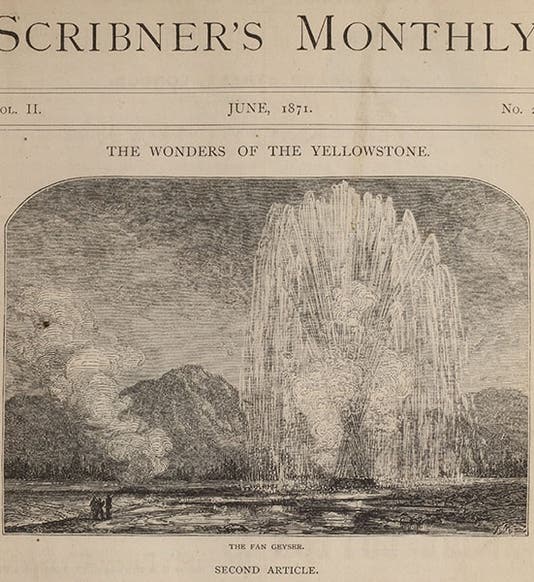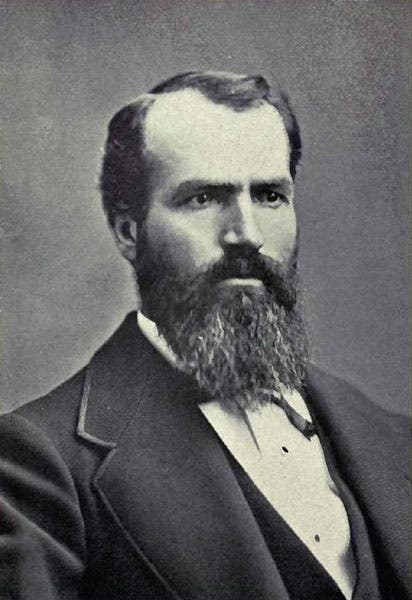Scientist of the Day - Nathaniel P. Langford
On Sep. 18, 1870, a party of explorers rode into Upper Yellowstone Basin and sighted a geyser in full eruption. The expedition was led by Henry Washburn, the newly appointed Surveyor-General of Montana territory, and he was accompanied by a small contingent of soldiers, and by Nathaniel P. Langford. Langford (born Aug. 9, 1832; died Oct. 18, 1911) was an entrepreneur, explorer, administrator, and writer, who held various positions with the Territory of Montana.
That first geyser delighted everyone. Langford wrote: "It spouted at regular intervals nine times during our stay, the columns of boiling water being thrown from ninety to one hundred and twenty-five feet at each discharge, which lasted from fifteen to twenty minutes. We gave it the name of "Old Faithful." A little further up the basin, they saw another geyser, even more impressive, which they named “The Castle”; then three more, "The Fan", “The Beehive,” and “The Giant;” and finally, the queen of them all, “The Giantess”. Upon their return, Langford wrote an article for Scribner’s Monthly, which appeared in two parts in May and June, 1871. He presented an exciting account of their discovery of the Lower and Upper Falls of the Yellowstone River, and of the splendors of the Upper Geyser Basin. It is interesting that Langford was less impressed by Old Faithful, which he didn’t even illustrate, than the other geysers, especially the Giantess, which he thought was the grandest sight he had ever seen. There is a map of the geyser basin in the second Scribner's article; Old Faithful is labelled at bottom center, with the Giantess across the river to the right (second image). The article opens with a view of the Fan geyser, which is at the upper left of the map, and opens our post as well (first image).

“Bird’s-eye view of the Geyser Basin,” with Old Faithful at bottom center, Nathaniel P. Langford, Scribner’s Monthly, June 1871 (author’s collection)
There were also several attractive general views in the magazine of the Upper and Lower Basin and the Canyon of the Yellowstone. Interestingly, several of these woodcuts, including that of the Giantess, were made and signed by a young artist who did not even make the trip. His name was Thomas Moran. He would visit Yellowstone later that year, as a member of the Hayden expedition of 1871. One of the products of his trip was a monumental painting, The Grand Canyon of the Yellowstone (1872), which was hung in the US Capitol and played a significant role in convincing Congress to declare Yellowstone our first National Park in 1872. We wrote a post once on Thomas Moran, where you can see his painting, and also a two-page spread from Langford's Scribner's article, which shows three of Moran's woodcuts of Yellowstone’s geyser's.
Langford was installed as the first superintendent of Yellowstone National Park in 1872. Unfortunately, he had no salary, was given no funds to run the park, and had no authority to prosecute park violators. He lost his job in 1877, ostensibly because he did not do any of the things for which he was given no funding or power to do. Some things in government never change.
Langford later wrote a book, The Discovery of Yellowstone Park – Diary of the Washburn Expedition to the Yellowstone and Firehole Rivers in the Year 1870 (1905), a copy of which we have just located and now have on order for the Library (thank you, Jason Dean!). There is a portrait in this work of an older Langford. The portrait we reproduce here (third image) shows him at about the time of the Yellowstone expedition of 1870.
Dr. William B. Ashworth, Jr., Consultant for the History of Science, Linda Hall Library and Associate Professor emeritus, Department of History, University of Missouri-Kansas City. Comments or corrections are welcome; please direct to ashworthw@umkc.edu.







